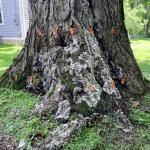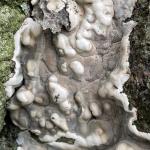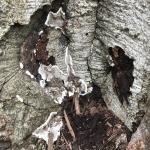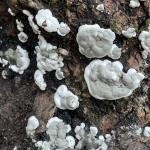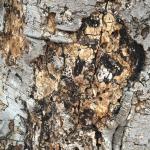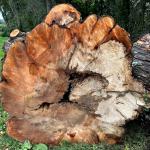Root and Butt Rot caused by Kretzschmaria deusta
Pathogen
The fungal pathogen Kretzschmaria deusta is sometimes known as the burnt crust fungus, brittle cinder fungus, and coal fungus. Older literature refers to the fungus as Ustulina vulgaris (Luley 2022).
Hosts
Root and butt rot from Kretzschmaria is most common on European beech (Fagus sylvatica) across managed landscapes in southern New England. The fungus can also be found on American beech (F. grandifolia), sugar maple (Acer saccharum), red maple (A. rubrum) and Norway maple (A. platanoides). Less frequent hosts include birch (Betula), hackberry (Celtis), ash (Fraxinus), apple (Malus), oak (Quercus), and linden/basswood (Tilia) (Hepting 1971; Sinclair and Lyon 2005).
Symptoms & Signs
Kretzschmaria is one of the most destructive root and lower trunk rot pathogens of deciduous hardwoods in the northeast (Luley 2022). The fungus is capable of decaying both lignin and cellulose. However, unlike many white rot fungi, cellulose is preferentially targeted during the decay process. As cellulose is decayed, the infected wood tissue rapidly loses strength (Schwarze et al. 2000). Yet, due to the pattern of decay this fungus exhibits, the wood can still appear relatively sound. According to Silverborg (1954), the decay column extends roughly 3-4 feet above the fruiting bodies. Infections can initiate in the roots and spread to the base, where the fungus causes a butt rot of the lower trunk. Additionally, Kretzschmaria can colonize basal wounds (i.e. those caused by mowers or string trimmers), which are unfortunately common on large beech and maple in managed landscapes. The decaying wood appears bleached with distinct black zone lines intermixed throughout (Sinclair and Lyon 2005). Like many root and butt rot diseases, symptoms of infection may be cryptic to non-existent. Undersized foliage, canopy dieback, basal cankers, sap flow and sloughing bark can develop as infections intensify. Bleeding cankers can also develop and may be confused with those caused by Phytophthora.
Signs of the pathogen include gray-colored fruiting bodies with bright white margins that are produced from late spring to early summer, being most conspicuous in May in Massachusetts. At times, they can appear in mid-summer (e.g. July). These fruiting bodies appear mostly flattened (appressed) and are very different from the conks and mushrooms produced by other common wood-rotting pathogens. Upon closer inspection, the fruiting bodies appear as lumpy masses growing from infected bark. Over time, they become dark black in color and may be difficult to identify on dead, sloughing bark soaked with sap. The fruiting bodies are almost always produced very close to the soil line but may be higher on the trunk when advanced infections exist.
Management
Kretzschmaria produces airborne spores from fruiting bodies that can spread to nearby beech or maple. Neighboring trees are most susceptible when they have with basal cankers or wounds. Spread also likely occurs through root grafts between susceptible trees. However, overland spread is believed to be limited as multiple infected trees in a "disease pocket" are uncommon in landscape and forest settings. Nothing can be done to eradicate the pathogen once present since the fungus lives in roots and the heartwood. As with any tree infected by a root and butt rot pathogen, maintaining high tree vigor is important. If annual increment growth can keep pace with the rate of decay in the heartwood, this may reduce the risk of failure. Maintain a large ring of mulch or wood chips around the tree and manage insect pests and pathogens that can weaken the tree. Improving soil quality may also increase vigor. Pruning to reduce canopy sway can also be performed. Minimally invasive decay detection techniques, such as resistance drilling and sonic tomography, are often required to understand the full extent of the decay. A basal trunk application of phosphites may help to slow the progression of the disease into the sapwood and cambium but ultimately the tree will die as a result of the disease. Upon death, the stump and infected roots should be removed from the site if another tree is to be planted. If the stump is left, the fungus will persist on site and may infect a newly planted tree nearby. Avoid replanting with beech or maple in the same location where an infected tree died.
References
Hepting GH. 1971. Diseases of Forest and Shade Trees of the United States. Washington, DC: USDA Agricultural Handbook No. 386.
Luley, CJ. 2022. Kretzschmaria deusta. In: Wood Decay Fungi Common to the Northeast & Central United States, 2nd Edition. Urban Forest Diagnostics LLC, Naples, NY. Pp. 54–55.
Schwarze FWMR, Engels J, and Mattheck C. 2000. Fungal Strategies of Wood Decay in Trees. Springer, Berlin, Germany.
Sinclair WA and Lyon HH. 2005. Diseases of Trees and Shrubs, 2nd edn. Cornell University Press, Ithaca, NY.
Silverborg, SB. 1954. Northern Hardwoods Cull Manual. State University of New York, Bulletin 31. 45 p.
